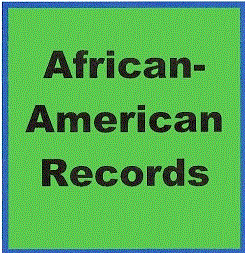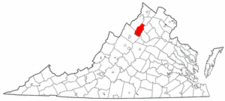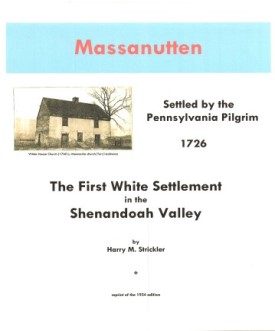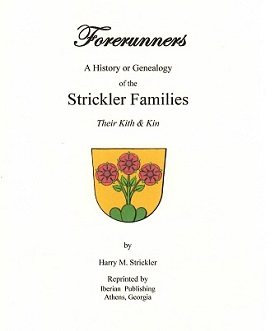






 
Home
Reference
Census Records
Military
African-American
Other States
New Titles
E-BOOKS
FREE SHIPPING IN USA
Iberian Publishing Company's On-Line Catalog:
Page County Virginia
 Page County was formed in 1831 from portions of Shenandoah and Rockingham counties and named for John Page, revolutionary patriot, congressman, and governor of Virginia from 1802 to 1805. Its boundaries have remained stable since its founding.
The settlers for the region came from a variety of sources: Germans and Swiss from Spotswood's Germanna Colony drifted through the gaps of the Blue Ridge into what was then called "Messenutten"; Pennsylvania Germans and a number of Mennonite families came down the Indian path; and Scotch-Irish came in considerable numbers to populate the small towns in the area. Most genealogists and historians agree that these settlers in Massanutten were the first permanent settlers west of the Blue ridge, beginning their homesteads as early as 1726. Many of their records can be found in the archives of Spotsylvania and Orange counties.
The Page Valley remained among the most remote regions of the Shenandoah Valley, and the formation of the new county in 1831 was perhaps recognition of its slowly-developing economy and connection with the ironworks at Harpers Ferry. Large quantities of ore were shipped from Page Valley to provide the raw material for this booming industry in the post 1830s. Page County was formed in 1831 from portions of Shenandoah and Rockingham counties and named for John Page, revolutionary patriot, congressman, and governor of Virginia from 1802 to 1805. Its boundaries have remained stable since its founding.
The settlers for the region came from a variety of sources: Germans and Swiss from Spotswood's Germanna Colony drifted through the gaps of the Blue Ridge into what was then called "Messenutten"; Pennsylvania Germans and a number of Mennonite families came down the Indian path; and Scotch-Irish came in considerable numbers to populate the small towns in the area. Most genealogists and historians agree that these settlers in Massanutten were the first permanent settlers west of the Blue ridge, beginning their homesteads as early as 1726. Many of their records can be found in the archives of Spotsylvania and Orange counties.
The Page Valley remained among the most remote regions of the Shenandoah Valley, and the formation of the new county in 1831 was perhaps recognition of its slowly-developing economy and connection with the ironworks at Harpers Ferry. Large quantities of ore were shipped from Page Valley to provide the raw material for this booming industry in the post 1830s.
For a better understanding of county boundary changes, see our new section Virginia in Maps
Iberian also has hundreds of titles in e book (PDF) format!! Click here for a complete online catalog of available titles
  MASSANUTTEN: SETTLED BY THE PENNSYLVANIA PILGRIM (1726) by Harry M. Strickler.
2024 (facsimile reprint of the 1924 edition, 182 pp.
MASSANUTTEN: SETTLED BY THE PENNSYLVANIA PILGRIM (1726) by Harry M. Strickler.
2024 (facsimile reprint of the 1924 edition, 182 pp.
A facsimile reprint of a classic work. Harry Strickler weaves extensive research and primary sources into a tale which opens the lives of the colonial settlers to the reader. This group of Pennsylvania Swiss and German pioneers established the first European settlement west of the Blue Ridge. Strickler explores the cultural and social dynamics of the early settlers, including their religious beliefs, customs, and traditions. Along the way he provides the reader with details that only an on-the-site observer and direct descendant could give. Lots of genealogical information, and a good read!
To view a digital copy (pdf) of the index to this book, visit Index-Msnt
(Close the pdf file with the left arrow to return to Iberian's catalog)
[Msnt] $25.00
The above title is also available as a digital e-book in searchable PDF format:
[EMSNT] $15.00 electronic version
 FORERUNNERS: A HISTORY OR GENEALOGY OF THE STRICKLER FAMILIES, THEIR KITH AND KIN Strickler, Harry M., 1925. Reprinted by New Papyrus Publishing Co., 1998.
Harry Strickler's classic work on the Stricklers of the Shenandoah Valley is back in print. Included in this early work is material on not only on
the Stricklers, but also collaterial lines among the following families. Kauffmans, Stovers, Burners, Ruffners, Beavers, Shavers, Brumbachs, Zirkles,
Blossers, Groves, Brubakers, Neffs, Rothgebs, and many other early families of Shenandoah, Rockingham, Frederick, Augusta and Page Counties, Virginia. FORERUNNERS: A HISTORY OR GENEALOGY OF THE STRICKLER FAMILIES, THEIR KITH AND KIN Strickler, Harry M., 1925. Reprinted by New Papyrus Publishing Co., 1998.
Harry Strickler's classic work on the Stricklers of the Shenandoah Valley is back in print. Included in this early work is material on not only on
the Stricklers, but also collaterial lines among the following families. Kauffmans, Stovers, Burners, Ruffners, Beavers, Shavers, Brumbachs, Zirkles,
Blossers, Groves, Brubakers, Neffs, Rothgebs, and many other early families of Shenandoah, Rockingham, Frederick, Augusta and Page Counties, Virginia.
To view a digital copy of the index to this book, visit Index-Fore
(Use your back arrow to return to Iberian's catalog)
[Fore] $32.00
The above title is also available as a digital e-book in PDF format:
[Efore] $20.00 (electronic version)
PAGE COUNTY, VIRGINIA MEN IN GRAY
compiled by Thomas M. Spratt. 1994, ca. 400 pages, index. A continuation of the same series as
"Shenandoah County Men in Gray" (see Shenandoah county for details).
To view a digital copy (pdf) of the index to this book, visit Index-Pcmg
(Close the pdf file with the left arrow to return to Iberian's catalog)
[Pcmg] $29.95
The above title is also available as a digital e-book in PDF format:
[EPCMG] $19.00 (electronic version)
PAGE COUNTY,VIRGINIA 1840 CENSUS
John Vogt, 2007, vi, 63 pages, indices,
figures.The Sixth Census of the United States in 1840 is the first glimpse we have of the population and its distribution, both geographically and demographically for Page County. Although a publication of this census was made nearly two decades ago (1990), it omitted the free colored and slave sections, as well as the occupational and educational portions of the census. These can be extremely valuable in discerning the area and social status of a family, as well as giving an insight into the occupations. In addition, this researcher uncovered more than 125 mis-transcriptions of names, as well as five families simply omitted in the earlier publication. Hence this new census transcription.
William M. Keyes, an Assistant to the Marshall of the Western District of Virginia, conducted the census to reflect the households of the county as they existed on June 1, 1840. The census was taken over the summer and early fall of that year, and he had his work certified by a justice of the peace on October 30, 1840. In all, the total population of the county consisted of 6,184 souls, made up from 898 households. A total of 741 slaves were held by 170 families, or about one in five families. Only a relative few held more than ten slaves.
The only town in the county and the county seat, Luray, consisted of 375 persons, including 96 slaves, distributed among forty families. The only other large settlements were located at the foundaries of Blackford and Forrerís, the two primary manufacturing centers. By and large, the remainder of the county was a rural, agricultural area. Mills were scattered throughout the county, as later references show, but none of the were reflected in the census documentation.
One important area overlooked in the census data for 1840 is that of education. The presence of at least ten organized primary or common schools attest to the emphasis placed upon education by most families. Of all the adults over 21 in the county, about 330 listed themselves as unable to read and write. This information is contained at the far right margin of the second folio in each entry. Research in the location of these schools would probably reveal a great deal about the growth of small hamlets and later urban settlements in the county. While Luray was the only community singled out in the census, smaller hamlets such as Stanley, Marksville, Rileyville, Stony Man, and others were beginning to emerge by this time. And as they grew, the need for basic education facilities became important.
To view a digital copy (pdf) of the index to this book, visit Index-Pg40
(Close the pdf file with the left arrow to return to Iberian's catalog)
[Pg40] $14.95
The above title is also available as a digital e-book in PDF format:
[EPG40] $10.00 (electronic version)
PAGE COUNTY MARRIAGE BONDS, 1831-1850
John Vogt & T. William Kethley, Jr. 1983, viii, 57 pages, indices,
figure, map. Page County was created in 1831 from portions of Shenandoah and Rockingham counties. All
of the original clerk's registers for these vital statistics are in the county court house in Luray. From this
register of bonds a total of 858 marriages were abstracted.
[Page] $10.95
The above title is also available as a digital e-book in PDF format:
[EPAGE] $7.00 (electronic version)
PAGE COUNTY, VA LAND TAX REGISTERS 1858-1859 [Facsimile edition]
with an introduction and index by Chester E. Ramey, III. 1995, 11" x 17" format, 113 pages,
index. The publication is printed from one of two known copies of the Land
Tax records for Page County, Virginia for the years 1858 and 1859 (The other
is the auditor's copy in the State Archives). As of the summer of 1994,
the Page County courthouse did not have their copy for those two years.
In fact, very few Land Tax books exist prior to 1865, mostly due to water
damage. As reported in the December 22, 1892 edition of the Page News and
Courier, most county records were hidden in a cave (on William R. Almond's
farm near Hope Mills) during the Civil War. When the boxes were taken out
of the cave, it was discovered that they were floating in water. The
existing copy is more than likely the Sheriff's copy. A valuable tool
for researching valley families.
To view a digital copy (pdf) of the index to this book, visit Index-Pglr
(Close the pdf file with the left arrow to return to Iberian's catalog)
[Pglr] $35.00
The above title is also available as a digital e-book in PDF format:
[EPGLR] $20.00 (electronic version)
For more records pertaining to PAGE COUNTY, VIRGINIA see also:
    
Please see our HELP PAGE for mail-order instructions, wholesaler policies and other contact information.
|| Virginia/W.Va. || General Reference || Military Records ||
|| Other States || E-Books || New Titles || Home Page || E-Books ||
Copyright 2025 Iberian Publishing Company
|